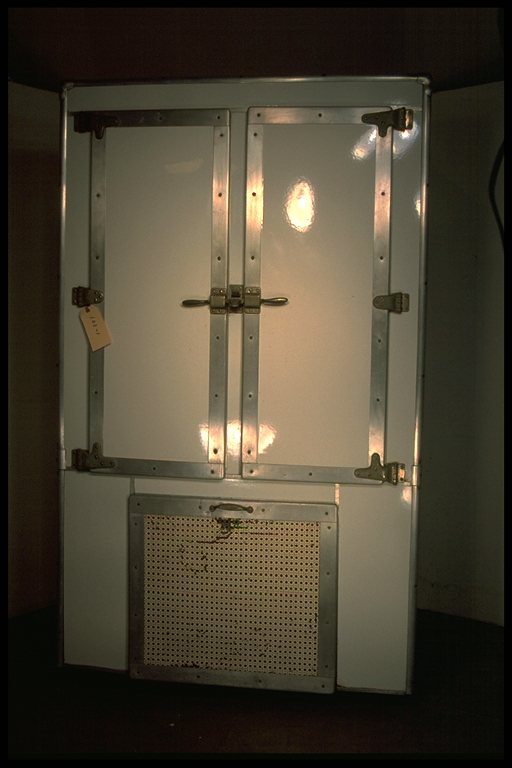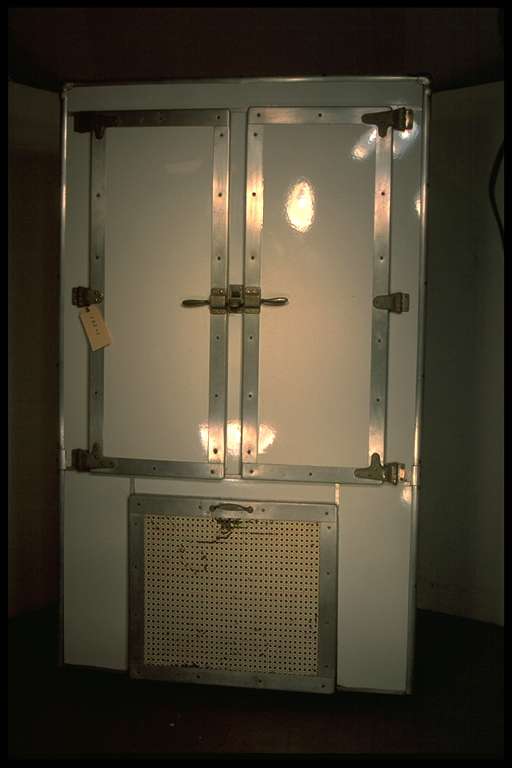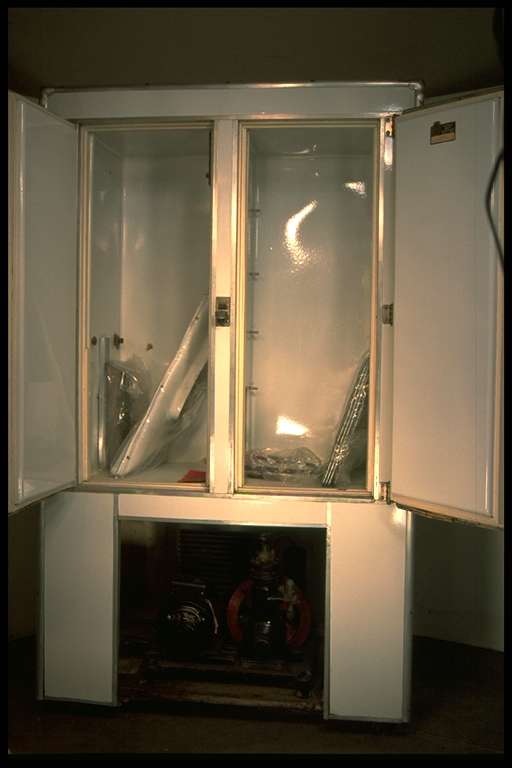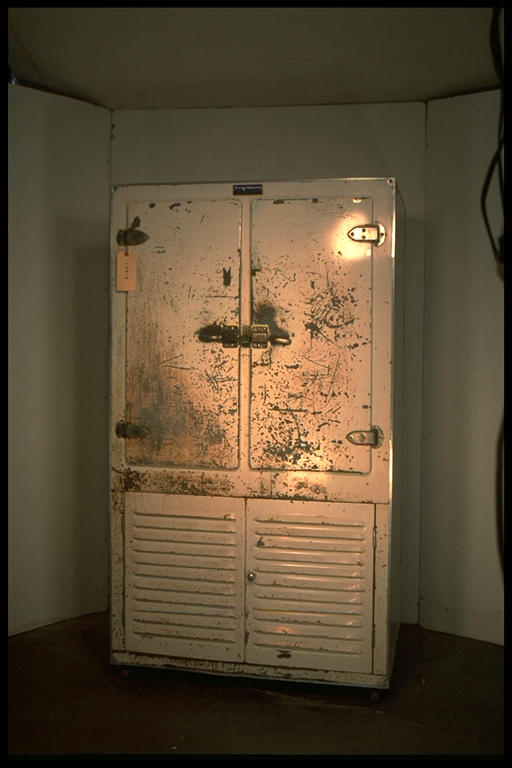1.03-1: Kelvinator 1928 Double Door, Cabinet Refrigerator

| HHCC Accession No. 2003.008 | HHCC Classification Code: 1.03-1 |
|---|
Description:
Nine and One Half Cubic Foot, Double door, Cabinet Refrigerator, Frigidaire, 1926
Group:
1.03 Unitary Refrig and A/C Equipment and Systems - Commercial Refrigerating Equipment
Make:
Kelvinator
Manufacturer:
Kelvinator of Canada, London Ont.
Model:
233
Serial No.:
1700
Size:
41x 25x 70”h
Weight:
360 lls
Circa:
1928
Rating:
Exhibit Quality, Rare example of the genre in white porcelain exterior finish ,
Patent Date/Number:
Sept 1910 to May 1921
Provenance:
From York County (York Region) Ontario, once a rich agricultural hinterlands, attracting early settlement in the last years of the 18th century. Located on the north slopes of the Oak Ridges Moraine, within 20 miles of Toronto, the County would also attract early ex-urban development, to be come a wealthy market place for the emerging household and consumer technologies of the early and mid 20th century.
This artifact was discovered in the 1950’s in the used stock of T. H. Oliver, Refrigeration and Electric Sales and Service, Aurora, Ontario, an early worker in the field of agricultural, industrial and consumer technology.
Type and Design:
Unitary design and construction with natural cork insulated refrigerated cabinet, self-contained refrigerant condensing unit, 1/4 HP electric motor. Refrigerating Unit (Condensing Unit): Type: Operating system type, compression refrigeration type, theoretical Carnot cycle; Self-contained condensing unit with belts driven compressor, single-phase electric motor, and air-cooled condenser. Non-hermetic design, steel base with coil spring mounting/steel legs,
Construction:
Wooden frame construction, 2” natural Cork insulation with expressed, bolted, applied, porcelain steel panels, with curved, cast aluminium, archetectural corners in Art Deco style of the period
Material:
Special Features:
Four heavy galvanised steel wire shelves; evaporator baffles (evaporator not included), early refrigerator lift latches in pristine condition
Accessories:
: Original sales, service and engineering manuals
Capacities:
120 volts, 1/4 HP, 3.5 amps
Performance Characteristics:
Operation:
Control and Regulation:
Targeted Market Segment:
In addition to its market potential for small grocery stores of the times, a nine cubic foot refrigerator with ample icemaker was an elite piece of household equipment for the early 1930’s. It was marketed for the homes of the wealthy, a carefully targeted segment of the population (See also Report 009)
Consumer Acceptance:
Merchandising:
Market Price:
Technological Significance:
Unitary Refrigeration Equipment: The idea of a unitary piece of refrigeration or air conditioning equipment was a significant one in its own right, one that had to wait its time. The scientists, engineers and inventors in the early years of the 20th century were intrigued and obsessed with the power of the technology and of its possible market potential. What they saw was the newly discovered principles of physics and heat engines - following, for example, the early works of Carnot, Faraday, Kelvin, and the later work of Perkins, Larsen and Carrier, to name a few.
They understood the promise of the technology for the public good, not to say its consumer sales potential. Early engineering work advanced on a multiple fronts with development of compressors, heat exchangers, valves and piping variously strung together in configurations that would be found to work, but only after much experimentation.
The arrival of unitary equipment, all those parts organised into a single whole, a single unit of construction, a ‘black box’, that could be offered to the consumer market was a significant technological and cultural event. Technologically the refrigerator would need to be seen to be safe, reliable, maintainable and useful. As well, in order to attract the development capital needed, it must be seen as potentially saleable and affordable, contributing to life’s needs and desires. Its socio- cultural and economic significance was marked, for it would change much. As Canadians we would quickly come enjoy potentially healthier lives, expect new levels of comfort and convenience, with a broader, safer, more diverse and enjoyable diet.
As a result, Canadians would quickly come to think of their day differently, for the day would be defined and punctuated in different ways than ever before, as a result of the introduction of modern, electric, household appliances, of which refrigerators, freezers and room air conditioners would be a central part, by the mid 20th century
J. M Larsen produced a manually operated household refrigerator of sorts in 1913, but it was not until 1918 that the Kelvinator Company marketed the first automatic, unitary refrigerator for the home. In that year, it is reported to have sold sixty-seven machines. (See Note 1) The historic artifacts in Group 1.00, Unitary Equipment, including significant samplings the early work of Kelvinator of Canada, provide a rare view of the evolution of unitary refrigeration and air conditioning applications, as they evolved in Canada in the first half of the 20th century.
For those formative years, the artifacts in this Group, 1.00, are typical of the offerings of the Canadian refrigeration and air conditioning industry. They personified the applications found in the homes, farms and commercial premises of the period for, those that could afford life’s new amenities of comfort, convenience and privilege.
The Significance of this Specimen: The significant contribution of refrigerators, represented by this specimen lies in the market for the technology opened up for larger refrigerators, which would grace the kitchens of wealthy estates throughout the 1930’s, as well as being found in a new generation of food retailers, the family run,”mumma and papa” store of the pre WW II era.
Industrial Significance:
Socio-economic Significance:
Socio-cultural Significance:
Donor:
G. Leslie Oliver, The T. H. Oliver HVACR Collection
HHCC Storage Location:
Tracking:
Bibliographic References:
Kelvinator Service Manual, 1928


